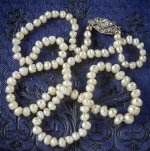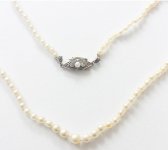You are using an out of date browser. It may not display this or other websites correctly.
You should upgrade or use an alternative browser.
You should upgrade or use an alternative browser.
What do I have here
- Thread starter Johanna1
- Start date
CortezPearls
PG Forum Admin
Hi Johanna! Good to see you back 
Both seem like freshwater pearl necklaces to me, the one with the blue background seems more like potato pearls...the one with a light background doesn't offer much contrast so it's harder to even see many traits. If you have that one with a beige or gray background it would be nice!
Both seem like freshwater pearl necklaces to me, the one with the blue background seems more like potato pearls...the one with a light background doesn't offer much contrast so it's harder to even see many traits. If you have that one with a beige or gray background it would be nice!
Johanna,
We do enjoy seeing and analyzing the characteristics of your pearl pieces. A few years back, this list was compiled by our admins to help give us info and photos to best help us identify the pearls. Although it may not seem logical, a white paper towel as background for photos is an excellent choice.
These usefull suggestions are taken from a "sticky" posted under this topic:
"1. Do the pearls feel slightly gritty or smooth when rubbed gently against another pearl (or against the edge of your tooth, if there is only one pearl?) Please rub gently!
If they are gritty, they are likely to be real nacre (genuine pearls.) If they feel smooth, they are likely imitation pearls.
2. Please provide clear, in-focus photos without flash against a white background (a paper towel works nicely.)
Include close-ups of the clasp (front and back) and a few of the pearls. If there are flaws, include a photo of those. Also the box they came in, and tags if you have them.
3. Any history you can give us about the pearls. Where/when you or your relative got them, any documentation you have (receipts, appraisals), their price range if you know it, etc.
4. Describe any marks on the clasp. These may be numbers (14K, 585, 750, 925 etc.) or brand names or even pictures. If the clasp has stones, have you had them tested, or do you have documentation about what they are?
5. Measure the pearls, with a millimeter ruler if possible. If they are graduated, measure the largest and smallest pearls."
We do enjoy seeing and analyzing the characteristics of your pearl pieces. A few years back, this list was compiled by our admins to help give us info and photos to best help us identify the pearls. Although it may not seem logical, a white paper towel as background for photos is an excellent choice.
These usefull suggestions are taken from a "sticky" posted under this topic:
"1. Do the pearls feel slightly gritty or smooth when rubbed gently against another pearl (or against the edge of your tooth, if there is only one pearl?) Please rub gently!
If they are gritty, they are likely to be real nacre (genuine pearls.) If they feel smooth, they are likely imitation pearls.
2. Please provide clear, in-focus photos without flash against a white background (a paper towel works nicely.)
Include close-ups of the clasp (front and back) and a few of the pearls. If there are flaws, include a photo of those. Also the box they came in, and tags if you have them.
3. Any history you can give us about the pearls. Where/when you or your relative got them, any documentation you have (receipts, appraisals), their price range if you know it, etc.
4. Describe any marks on the clasp. These may be numbers (14K, 585, 750, 925 etc.) or brand names or even pictures. If the clasp has stones, have you had them tested, or do you have documentation about what they are?
5. Measure the pearls, with a millimeter ruler if possible. If they are graduated, measure the largest and smallest pearls."
CortezPearls
PG Forum Admin
jshepherd
Pearl Paradise
I think you have some interesting pearls there. One strand appears to be an antique American freshwater strand to me. The other looks like an antique 3.5 momme akoya strand.
This is a natural American freshwater choker from my personal collection.

This is an old strand of graduated Japanese akoya pearls, also from my personal collection.

This is a natural American freshwater choker from my personal collection.
This is an old strand of graduated Japanese akoya pearls, also from my personal collection.
CortezPearls
PG Forum Admin
These are great Jeremy! And maybe @Johana1 should take a good look at those pearls, take some photos and share them with the forum! 

jshepherd
Pearl Paradise
Looking more closely at the smaller strand, it may actually be a small natural saltwater strand. The graduation looks smaller than a 3.5 momme, even though the shape is consistent.
To give you a little more information the smaller strand on the white background is 18 inches long, pearl size ranging from 4mm to 2 mm. the clasp is platinum set with tiny old cut diamonds and a pearl. I don’t know if this helps.
jshepherd
Pearl Paradise
The small strand is probably also natural. 3.5 momme strands are larger, and it does look very similar to small natural strands I've seen in the past.
parfaitelumiere
Member
- Joined
- Dec 28, 2017
- Messages
- 171
Hi
First one could be old american freshwater, or saltwater.
I saw both types in the past.
The mount seems to be original, maybe american, or from UK, victorian era, with 2 yellow gold parts on sides, for me it means pearls are old, so definitely not cultured freshwater (biwa for example)
I never saw this type of mount in french jewelry.
The second one is natural saltwater pearl necklace, calibrated round pearls, probably hundred years old or so, and worn, making the barrel shape.
First one could be old american freshwater, or saltwater.
I saw both types in the past.
The mount seems to be original, maybe american, or from UK, victorian era, with 2 yellow gold parts on sides, for me it means pearls are old, so definitely not cultured freshwater (biwa for example)
I never saw this type of mount in french jewelry.
The second one is natural saltwater pearl necklace, calibrated round pearls, probably hundred years old or so, and worn, making the barrel shape.
Last edited:
Lagoon Island Pearls
Well-known member
- Joined
- Dec 8, 2009
- Messages
- 2,143
Jeremy has included an early natural freshwater strand for comparison, which is clearly that. Graded for size (graduation) first, then luster, color and shape by lessening degrees. Each markedly dissimilar at the nuclei. This is what we'd expect from most natural strands, especially ones created from a small pool of pearls.
As to the OP, given the overall uniformity of the secondary and tertiary points mentioned, these preclude natural origin. For these reasons, I'd suggest early cultured pearls. Fresh or salt water origin unknown.
As to the OP, given the overall uniformity of the secondary and tertiary points mentioned, these preclude natural origin. For these reasons, I'd suggest early cultured pearls. Fresh or salt water origin unknown.
Similar threads
- Replies
- 6
- Views
- 682



 this is part of a "sticky note" at the top here, not originally from me, but compiled by Admin, so we would have as much info as possible when evaluating the pearl pieces.
this is part of a "sticky note" at the top here, not originally from me, but compiled by Admin, so we would have as much info as possible when evaluating the pearl pieces.